
Rookwood Cemetery is a heritage-listed cemetery in Rookwood, Sydney, Australia. It is the largest necropolis in the Southern Hemisphere and is the world's largest remaining operating cemetery from the Victorian era. It is close to Lidcombe railway station about 17 kilometres (11 mi) west of the Sydney central business district. It was added to the New South Wales State Heritage Register on 2 April 1999.

Central is a heritage-listed railway station located in the centre of Sydney, New South Wales, Australia. The station is Australia's largest and second busiest railway station, and is a major transport interchange for NSW TrainLink inter-city rail services, Sydney Trains commuter rail services, Sydney light rail services, bus services, and private coach transport services. The station is also known as Sydney Terminal. The property was added to the New South Wales State Heritage Register on 2 April 1999. It recorded 85.4 million passenger movements in 2018 and serves over 250,000 people daily.

Museum railway station is a heritage-listed underground commuter rail station that is located on the City Circle route at the southern end of Hyde Park in the Sydney central business district of New South Wales, Australia. The station is served by Sydney Trains T2 Inner West & Leppington and T3 Bankstown T8 Airport & South lines. The station is named after the nearby Australian Museum. It was added to the New South Wales State Heritage Register on 2 April 1999.

Strathfield railway station is a heritage-listed railway station located on the Main Suburban line in the Sydney suburb of Strathfield in the Municipality of Strathfield local government area of New South Wales, Australia. The station is served by Sydney Trains T1 North Shore & Western Line, T9 Northern Line and T2 Inner West & Leppington Line suburban services as well as NSW TrainLink Intercity and regional services. The station is located on the Main Northern and Main Western railway lines, forming a major junction for regional and suburban rail services. The station and associated infrastructure was added to the New South Wales State Heritage Register on 2 April 1999.

Lidcombe railway station is located on the Main Suburban line, serving the Sydney suburb of Lidcombe. It is served by Sydney Trains T1 Western, T2 Inner West & Leppington, T3 Bankstown and T7 Olympic line services.

Richmond railway station is the heritage-listed terminus railway station of the Richmond line, serving the Sydney suburb of Richmond, in New South Wales, Australia. It is served by Sydney Trains T1 Western and T5 Cumberland line services. It was added to the New South Wales State Heritage Register on 2 April 1999.
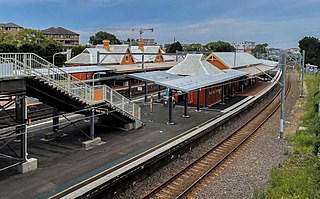
Arncliffe railway station is a heritage-listed railway station located on the Illawarra line, serving the Sydney suburb of Arncliffe in Bayside Council. It is served by Sydney Trains T4 line services. It was added to the New South Wales State Heritage Register on 2 April 1999.

Newcastle railway station is a heritage-listed closed railway station on the Newcastle railway line at Newcastle, New South Wales, Australia. It was the main railway station and terminus station prior to the curtailment of the Newcastle railway line.

Rookwood is a suburb in western Sydney, in the state of New South Wales, Australia located 14 kilometres (8.7 mi) west of the Sydney central business district, in the local government area of the Cumberland Council. It is the easternmost suburb in greater western Sydney.
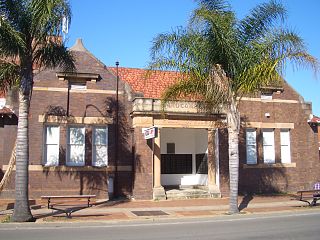
Lidcombe is a suburb in western Sydney, in the state of New South Wales, Australia. Lidcombe is located 15 km (9.32 mi) west of the Sydney central business district, in the local government area of Cumberland Council, with a small industrial part in the north in the City of Parramatta. Post code: 2141, sharing it with Berala.

All Saints Church is an Australian Anglican Church in the Canberra suburb of Ainslie. The church is in the Anglican Diocese of Canberra and Goulburn. The parish holds to a liberal Anglo-Catholic style of churchmanship and theology.
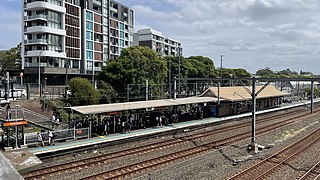
Petersham railway station is a heritage-listed railway station located on the Main Suburban line, serving the Sydney suburb of Petersham. It is served by Sydney Trains T2 Inner West & Leppington line services. It was added to the New South Wales State Heritage Register on 2 April 1999.
Cemetery Station No. 4 was a railway station on Sydney's Rookwood Cemetery railway line. It served the Rookwood Cemetery.

Cemetery Station No. 2 was a railway station on Sydney's Rookwood Cemetery railway line. It served the Rookwood Cemetery.
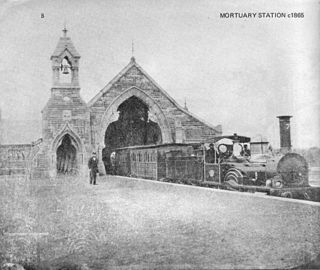
The Cemetery Station No. 1 was a railway station situated on the Rookwood Cemetery railway line in Sydney, New South Wales, Australia. Operating from 1867 to 1948, it primarily served the Rookwood Cemetery. The station's architectural design was overseen by James Barnet, the New South Wales Government Architect.

The Rookwood Cemetery Line used to be a part of the Sydney suburban network. The line serviced Rookwood Cemetery and was built in 1864, opening on 22 October 1864.
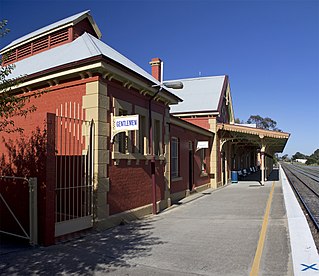
Queanbeyan railway station is a heritage-listed railway station located on the Bombala line in New South Wales, Australia. It serves the town of Queanbeyan.

Sydney, the largest city in Australia, has an extensive network of passenger and goods railways. The passenger system includes an extensive suburban railway network, operated by Sydney Trains, a metro network and a light rail network. A dedicated goods network also exists.

A funeral train carries a coffin or coffins (caskets) to a place of interment by railway. Funeral trains today are often reserved for leaders, national heroes, or government officials, as part of a state funeral, but in the past were sometimes the chief means of transporting coffins and mourners to graveyards. Many modern era funeral trains are hauled by operationally restored steam locomotives, due to the more romantic image of the steam train against more modern diesel or electric locomotives, although non-steam powered funeral trains have been used.

The Railway Square road overbridge is a heritage-listed road overbridge carrying George Street over the former Darling Harbour goods railway line at Railway Square in the Sydney central business district, Australia.



















